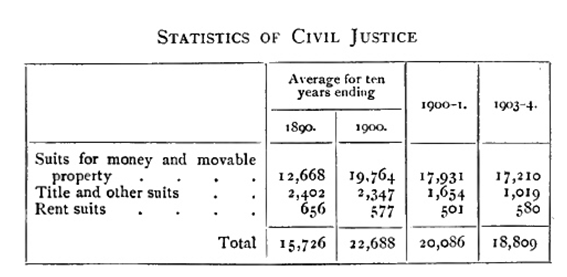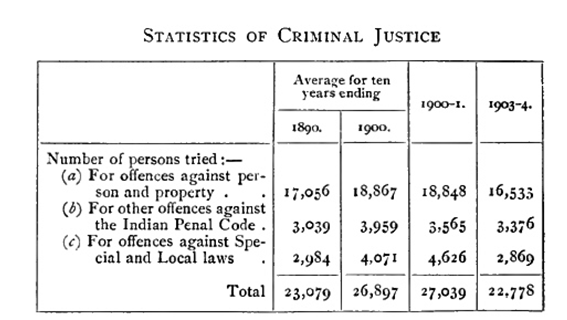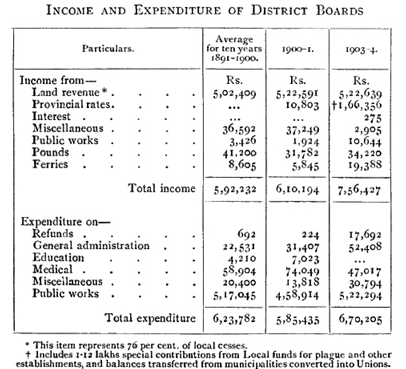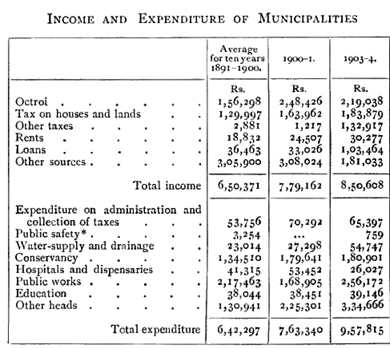Mysore State: Laws and Judiciary. 1909
This article was written between 1907- 1909 when conditions were Readers will be able to edit existing articles and post new articles |
From Imperial Gazetteer of India, 1907 – 1909
Mysore State (Maisūr): 1909
Laws
On the rendition in 1881 a schedule of Acts already in force in Mysore was appended to the Instrument of Transfer. A Legislative department, under a legislative secretary, was formed in 1886. There is no special Legislative Council. The various regulations passed into law up to 1901 have been revised and published in two volumes, forming the Mysore Code. The first volume contains the Acts passed before the rendition and then taken over from the British Administration ; the second volume contains the Regulations passed since. Among the later Regulations the following may be mentioned :
To amend the Code of Criminal Procedure (I of 1888),
Measures of Length (III of 1890),
to amend the Mysore Land Revenue Code (I of 1891),
Infant Marriages Prevention (X of 1894),
Village Sanitation (I of 1898),
General Clauses (III of 1899),
Electricity (IV of 1900),
to amend the Mysore Mines Act (VI of 1900),
Land Improvement Loans (I of 1901), Mysore Civil Courts (III of 1 901),
Code of Civil Procedure (VI of 1901),
Indian Evidence Act (VIII of 1901),
Local Boards (II of 1902),
Weights and Measures (III of 1902),
Registration (I of 1903).
Judiciary
In 1903 there were 16 Munsifs' courts, 5 Sub-Judges' courts, 3 District courts, and the Chief Court. Munsifs exercise original jurisdiction in cases up to Rs. 2,500 in value; Subordinate Judges have jurisdiction in cases from above Rs. 2,500 to Rs. 10,000, and hear appeals from decisions of Munsifs if referred to them by the District Judge ; District courts have unlimited jurisdiction, and hear appeals from decisions of Munsifs, and from those of Subordinate Judges within the limit of Rs. 3,000 ; the Chief Court, sitting as a bench of not less than two Judges, disposes of all other appeals brought before it.
In 1903 there were 122 Subordinate Magistrates, 3 Sessions Judges, 8 District Magistrates, and the Chief Court. The Subordinate Judges of Chikmugalūr, Chitaldroog, and Hassan were also invested with the powers of Assistant Sessions Judges. In 1887 the system of trial by jury was introduced in Sessions cases. For appellate jurisdiction in criminal cases, the benches of the Chief Court that sit for civil appellate work dispose also of criminal appeals. The Chief Court moreover acts as a court of reference and a court of revision.
zzzThe two principal sources of excise revenue are toddy and arrack. The former, drawn from the date-palm, and also from coco-nut, palmyra, and bagni palms, is the immemorial beverage of the agricultural classes, a mild and comparatively innocuous drink, its average alcoholic strength being 2½ per cent. Arrack, which is far stronger and more harmful, is chiefly consumed by industrial labourers, and has an average alcoholic strength of 39½ per cent.
The consumption of toddy is fairly stationary, while that of arrack has a decided tendency to increase year by year. Formerly the right to sell toddy was farmed out by Districts, and was virtually a monopoly in the hands of a few contractors, between whom and the Darbār was a large class of middlemen. Want of proper control not only led to the supply of inferior liquor, but threatened the destruction of the date groves themselves. The new system broke up each tāluk into convenient farms, which supplied a certain number of shops from particular groves.
The number of toddy shops remained the same, so that the increase of revenue was entirely due to the abolition of needless intermediaries. As regards arrack, the policy has been to enhance the duty gradually up to the highest point consistent with the prevention of illicit distillation or contraband importation.
In addition to this, the main causes which have tended to increase the revenue have been—the abolition in 1884 of all outlying distilleries and the concentration of manufacture in one distillery near Bangalore under centralized control ; and further, the separation in 1892 of the business of manufacture from that of distribution, and the adoption of a system for the sale of the privilege of retail vend.
These measures led to the manufacture being taken up by European firms with large capital and [S. 236] superior technical resources, thus reducing the cost. Supplies were conveyed under separate contract to bonded depots in the Districts. In 1897 the still-head duty was raised to Rs. 4-12, and the retail rate to Rs. 6-6, per gallon, for liquor 20° under proof. The sale of the right of vend, on the 'separate shop system' in the cities and Gold Fields, and on the 'vend rent system' in tāluks or circles of villages, has secured to the State what previously formed the profits of middlemen.
In 1898 a tree tax was introduced, for better regulating the consumption of toddy and conserving the date groves, the rate being Rs. 1-1 per tree per annum for date-trees, and corresponding rates for other palms. In 1901 a tree rent of 4 annas per tree per annum was levied on trees tapped for toddy. In 1903-4 there were 12 toddy depots and 3,837 retail shops, 962 of these being for the sale of bagni toddy. The number of trees tapped was 422,855, and the quantity of toddy consumed was 9,809,640 gallons. Retail shops for the sale of arrack numbered 931.
The issue of spirits from the distillery amounted to 43,482 gallons. The greatest consumption is, of course, in the cities and the Gold Fields. The other sources of excise revenue are country beer, foreign liquors, hemp drugs (gānja and mājum), and opium. In 1899 the proportion of alcohol in country beer was fixed so as not to exceed 8 per cent. by volume. A scale of licence fees for the sale of foreign liquors was also prescribed. Country-made foreign spirits of weaker strength were introduced in 1904 to meet the requirements of the people, who were found in their absence to have recourse to inferior foreign stuff.
Gānja is grown by contractors under departmental supervision in specified localities. There were 237 retail shops in 1903-4 for the sale of gānja and mājum, and 15,594 seers were sold. Opium, previously imported from Mālwā, has since 1903 been obtained from the Madras storehouse. There were 126 shops in 1903-4 licensed to sell opium, and 1,438 seers were consumed.
Up to 1901 there were ten Local fund circles, one for each of the eight Districts, and for the French Rocks and the Kolār Gold Fields. Two years later a new system was introduced, and a District board has been constituted for each District (in addition to the Kolār Gold Fields Sanitary Board), besides a tāluk board for each tāluk or sub-tāluk. In 1904 these boards consisted of 1,188 members, of whom 372 were appointed ex officio, and 816 were non-ofificial.
Tāluk boards (since 1905) consist of 15 members : namely, 5 official, 5 elected, and 5 appointed by the State. District boards consist of 25 members ; namely, one non-official elected for each tāluk of the District by the members of the tāluk board from their own body, and the rest ex officio or appointed by the State.
The members hold [S. 237] office ordinarily for three years. Their chief functions embrace the construction and maintenance of roads and bridges, with assistance of the Public Works department if required, improving and conserving the water-supply, the provision and upkeep of travellers' bungalows and musāfirkhānas (native resthouses), dispensaries, sanitation of villages, &c. Funds are obtained by a cess of one anna in the rupee on land revenue, and on revenue from excise, sayer, and forests.
In 1901 the number of municipalities was 124 (exclusive of the Civil and Military Station of Bangalore), of which 117 had a population under 10,000, and 7 a population of from 10,000 to 100,000. In 1904, 36 of the minor municipalities, which were not tāluk headquarters and had a population of less than 3,000, were converted into Unions, a panchāyat being appointed for each Union. A panchāyat consists of 5 to 12 members, appointed by the State. The 88 municipalities in 1904 had 1,049 members, of whom 285 were officials. All of the members are natives, except about 20 Europeans.
The Kolār Gold Fields Sanitary Board was constituted in September, 1899, with 3 ex-officio members, and 4 non-official members nominated by the Mining Board. Its jurisdiction extends over the Kolār Gold Fields Sanitary Circle, embracing the Gold Fields and many of the surrounding villages.
It deals with disposal of refuse, [S. 238] water-supply, prevention of overcrowding, drains and latrines, keeping and slaughter of live-stock, &c., burial and burning-grounds, prevention and treatment of infectious and contagious diseases, and underground sanitation of the mines.
The municipal board of the Civil and Military Station of Bangalore has consisted, since 1904, of a president, a medical officer, and 24 other members, 6 appointed by the Resident, and 18 elected, the former holding office for three years, and the latter for two. The Trades Association elect one member, Europeans and Eurasians 6, Muhammadans 3, and Hindus and others 8.
The Public Works department is controlled by a Chief Engineer, a Deputy-Chief Engineer, and two Superintending Engineers, who are in charge respectively of the Eastern and Western Circles. These are Royal Engineers or European officers. Separate branches have been formed for roads and buildings, and for irrigation.
The executive staff are, with few exceptions, natives trained in Indian Engineering Colleges. Local works on a large scale, which require professional skill, arc carried out by the Public Works department on requisition from other departments, by which the needed funds arc placed at their disposal. Of original works carried out by the department only a few can be mentioned. The railways include the line from Bangalore to Mysore [S. 239] and Nanjangūd south-westwards, to Gubbi westwards, to Hindupur northwards, and the Kolār Gold Fields and Birūr-Shimoga branches.
The irrigation works include the Srīrāmadevar anicut and channels, and others in Mysore and Hassan Districts, the great Māri Kanave, Bora Kanave, Srīnivasa Sāgara, and many more. The excellent system of roads through the formerly impassable mountainous parts of Kadūr District, and the fine ghāt roads through passes to the west coast, deserve special mention. With these should be named the great bridges over the Tungabhadra at Harihar, over the Hemāvati at Sakleshpur, and the bridges at Belūr, Bāle Honnur, Tippur, Tadasa, and other places over broad rivers. Of hospitals, the most important are the Bowring and Lady Curzon in the Civil and Military Station of Bangalore, and the Victoria in the city.
Other buildings include the public offices at Bangalore, the Palace, the Residency, the Central College, and Mayo Hall, the new Palace at Mysore city, with the public offices there, the Mahārājā's College, &c., and at Seringapatam the restoration of the Daryā Daulat.
Municipal and other water-supply schemes are represented by the Hesarghatta tank, the source of the Bangalore water-supply; the filling up of Pūrnaiya's Nullah at Mysore and the carrying out of the Kukarhalli and other water-works there ; the provision at Betmangala for the water-supply of the Kolār Gold Fields, and minor works of that nature in various towns.
The transmission of electric power from the Cauvery Falls to the Kolār Gold Fields having been successfully accomplished, electric lighting from the same source has been introduced into Bangalore and is being carried out at Mysore. Large extensions have been laid out and occupied in Bangalore and Mysore city, with a new town at the Gold Fields, all on the most modern principles.



